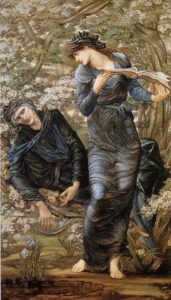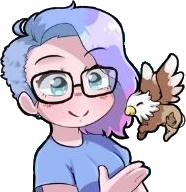 My love of Arthurian lore definitely began with a trio of books my aunt lent me as a kid, Mary Stewart’s Merlin Trilogy, The Crystal Cave, The Hollow Hills, and The Last Enchantment. I knew only a little about King Arthur and Merlin and the rest, and the allusions to historical Roman Britain and the grounding of Merlin’s vaunted magic in science was revelatory to me at the time, though I admit I didn’t wind up pursuing the path of historicity myself, instead cleaving to the fairy story aspects. My Arthur isn’t the much-debated 6th century British chieftain, but the boy who drew a sword from a stone. My Merlin is all seeing, all knowing, and can appear in any forest by passing through the hedgerows planted by Queen Gloriana in the Garden of Joy.
My love of Arthurian lore definitely began with a trio of books my aunt lent me as a kid, Mary Stewart’s Merlin Trilogy, The Crystal Cave, The Hollow Hills, and The Last Enchantment. I knew only a little about King Arthur and Merlin and the rest, and the allusions to historical Roman Britain and the grounding of Merlin’s vaunted magic in science was revelatory to me at the time, though I admit I didn’t wind up pursuing the path of historicity myself, instead cleaving to the fairy story aspects. My Arthur isn’t the much-debated 6th century British chieftain, but the boy who drew a sword from a stone. My Merlin is all seeing, all knowing, and can appear in any forest by passing through the hedgerows planted by Queen Gloriana in the Garden of Joy.
Nevertheless, Stewart led me to John Boorman’s Excalibur, which led me to Sir Thomas Mallory and T.H. White. Years later a woman I worked with lent me The Mists of Avalon, and it was the clash between Christianity and paganism there that arrested me. After reading Bradley I rediscovered Mary Stewart in the unofficial sequel to the Merlin Trilogy, the Morded-centric standalone novel, The Wicked Day.
All of these ingredients went into the mix of my forthcoming novel The Knight With Two Swords, a retelling and expansion of The Tale of Sir Balin related in Le Morte D’Arthur.
The titular Balin is a temperamental, reactionary knight, the greatest of Arthur’s champions prior to the arrival in Camelot of Sir Lancelot. He and his twin brother Brulen are affected early on by the murder of their pagan mother at the hands of Christian fanatics, yet the two brothers come away from the experience with very different outlooks; Balin blames the pagan sisterhood of Avalon for corrupting his mother, whereas Brulen sets himself as an outlaw against all that is Christian.
This makes the court of Camelot, where both the Archbishop Dubricius and Merlin the Enchanter have a hold of King Arthur’s ears, a bewildering place for Balin. He seethes, torn between serving God’s chosen king and striking down what he perceives as the serpents in his shadow.
His personal conflict comes to a head when a mysterious woman girded with an enchanted sword visits the court, and no man but Balin can draw it. Yet, she warns him, though it will make him the greatest knight in the land, it will also doom him to kill the one he loves best”¦.
This woman is Nimue, a familiar face in Arthurian lore. Named as one of the three queens who, along with Morgan Le Fay and The Queen of Norgales (who I’ll talk a little about later) ultimately accompanies the body of Arthur on his funeral barge, she is invariably described throughout the lore as an enchantress, the temptress who traps Merlin in a tree, and The Lady of The Lake herself.
The names of The Lady of The Lake are almost legion. There is Lile (who Phyllis Ann Karr in her Arthurian Companion suggests only became an individual when someone mistranslated the French “˜l’ile d’Avilion’ as “˜Lile of Avalon’), Viviane, Nineve, and Sebill from the Vulgate Cycle, to name a few. As others have done before me, in Knight With Two Swords, they have all held the office of Lady of The Lake, and as the embodiment of Balin’s scorn for Avalon and its pagan mysteries, definitely have an impact on the tragic course of his life.
Other, less well known female characters from across Arthurian lore make appearances too, such as the mother of Merlin, Adhan, and his sister Gwendydd, who probably first appeared in Cyfoesi Myrddin a Gwenddydd ei Chwaer, a poem from the Red Book of Hergest attributed to a bard named Myrddin. In the old story, Gwendyyd’s son is killed in battle by her brother, and Myrddin goes mad when she disavows him. Geoffrey of Monmouth calls her Ganieda in his later Vita Merlini, where she cuckolds her husband Rhydderch Hael, and Myrddin tells on her. Geoffrey Latinized Myrddin into Merlin, possibly replacing the “˜d’ with an ‘i’ because “˜Merdin’ sounded too close to “˜Merde’ (“˜shit’ in French). In The Knight With Two Swords, Gwendydd is the bridge between Nimue and Merlin, who will tutor her in the magic arts she employs to direct Balin as a weapon of her own personal quest for vengeance.
In the course of Balin’s adventures, he encounters the Aspetta Ventura or, “˜Expected Fortune,’ a castle mentioned in the 14th century Italian take on Tristan, La Tavola Ritonda. The mysterious chatelaine of the castle is Lady Verdoana, known as The Leprous Lady, a woman covered head to toe who demands every maiden who visits her submit to a bizarre bleeding ritual. Cursed by a spurned sorcerer, she can only be cured by the blood of a royal virgin. Needless to say, this leads to shenanigans when Balin and his traveling companions find themselves houseguests.
For the ultimate antagonist of The Knight With Two Swords, I looked to the aforementioned Queen of Norgales. Like The King With A Hundred Knights, she goes unnamed in most stories, popping up now and again in Malory and the French Vulgate Cycle tormenting Lancelot and plotting with Morgan. She is described as one of the three most powerful sorceresses of Britian, behind Morgan Le Fay and The Lady of the Lake. In The Knight With Two Swords, she is a mysterious elderly dowager, always veiled, content to direct the actions of her armies and agents from afar. The widow of a wicked king named Agrippe who invaded the Grail Kingdom at the behest of the Devil, she plays a long game of wits with Merlin himself, whom she considers her grandson, as it was she who set the demon that begat him upon his mother Adhan in a failed attempt to bring forth the antichrist.
The Knight With Two Swords is available in print December 21st, and drops on Kindle on the 26th.
Edward M. Erdelac is the author of twelve novels including Andersonville and The Merkabah Rider series. His fiction has appeared in dozens of anthologies and periodicals including the Stoker award winning After Death and Star Wars Insider Magazine. Born in Indiana, educated in Chicago, he lives in the Los Angeles area with his wife, three kids, and three cats. News and excerpt from his works can be found at:
http://www.emerdelac.wordpress.com
https://www.facebook.com/Edward-M-Erdelac-112183918691
https://twitter.com/EdwardMErdelac
Enjoy this writing advice and want more content like it? Check out the classes Cat gives via the Rambo Academy for Wayward Writers, which offers both on-demand and live online writing classes for fantasy and science fiction writers from Cat and other authors, including Ann Leckie, Seanan McGuire, Fran Wilde and other talents! All classes include three free slots.
If you’re an author or other fantasy and science fiction creative, and want to do a guest blog post, please check out the guest blog post guidelines.











2 Responses